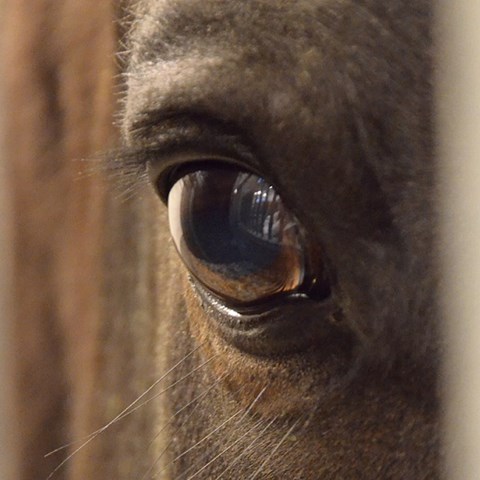Contact
Dep Programme director of studies - Veterinary Medicine programme
Lena Ström, Lecturer
Department of Clinical Sciences, Division of Diagnostics and Large Animal Clinical Sciences, SLU
Lena.Strom@slu.se, +46 18 67 14 69

Topical ophthalmic atropine sulfate is an important part of the treatment protocol in equine uveitis. Frequent administration of topical atropine may cause decreased intestinal motility and colic in horses due to systemic exposure. Atropine pharmacokinetics are unknown in horses and this knowledge gap could impede the use of atropine because of the presumed risk of unwanted effects. Additional information could therefore increase safety in atropine treatment.
Atropine sulfate (1 mg) was administered in two experiments: In part I, atropine sulfate was administered intravenously and topically (manually as eye drops and through a subpalpebral lavage system) to six horses to document atropine disposition. Blood-samples were collected regularly and plasma was analyzed for atropine using UHPLC-MS/MS. Atropine plasma concentration was below lower limit of quantification (0.05 μg/L) within five hours, after both topical and IV administration. Atropine data were analyzed by means of population compartmental modeling and pharmacokinetic parameters estimated.
The typical value was 1.7 L/kg for the steady-state volume of distribution. Total plasma clearance was 1.9 L/h‧kg. The bioavailability after administration of an ophthalmic preparation as an eye drop or topical infusion were 69 and 68%, respectively. The terminal half-life was short (0.8 h). In part II, topical ophthalmic atropine sulfate and control treatment was administered to four horses in two dosing regimens to assess the effect on gastro-intestinal motility.
Borborygmi-frequency monitored by auscultation was used for estimation of gut motility. A statistically significant decrease in intestinal motility was observed after administration of 1 mg topical ophthalmic atropine sulfate every three hours compared to control, but not after administration every six hours. Clinical signs of colic were not observed under any of the treatment protocols.
Taking the plasma exposure after topical administration into consideration, data and simulations indicate that eye drops administrated at a one and three hour interval will lead to atropine accumulation in plasma over 24 h but that a six hour interval allows total washout of atropine between two topical administrations. If constant corneal and conjunctival atropine exposure is required, a topical constant rate infusion at 5 μg/kg/24 h offers a safe alternative.
https://doi.org/10.1186/s12917-021-02847-4
Ström, L. Dalin, F. Domberg, M. Stenlund, C. Bondesson, U. Hedeland, M. Toutain, P-L. Ekstrand, C. 2021. Topical ophthalmic atropine in horses, pharmacokinetics and effect on intestinal motility. BMC Veterinary Research. (2021) 17:149
Lena Ström, Lecturer
Department of Clinical Sciences, Division of Diagnostics and Large Animal Clinical Sciences, SLU
Lena.Strom@slu.se, +46 18 67 14 69